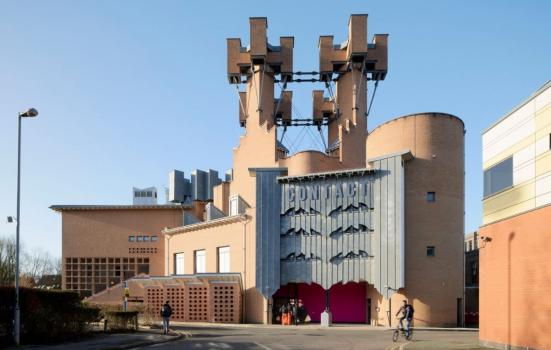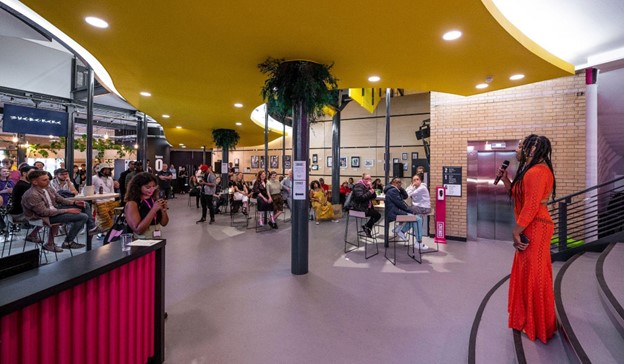Many arts organisations list patrons on their website but do we really understand their role? Megan Bennett shares her work building a patron portfolio at Contact.

Adrian Lambert
When I joined Contact in autumn 2021 it was slowly peering its head out of a major capital development project that had been delayed by Covid. What should have been a fabulous re-opening was lost in the noise of all other theatres re-opening at the same time.
Sitting at the bottom of a page under the Support Us section of the old website were some photos. They were of wonderful faces, of people full of talent and influence, but I was quick to ask what they actually did.
Initially, they were brought in to support the capital project. At the time, Contact was focusing efforts on raising as much money as possible to ensure the building would be as great as it could possibly be for all our audiences and young people.
Perhaps if we’d had a grand unveiling of the building as planned, all these faces would have been there in person to cut a red ribbon… But in lieu of that and, other than being invited to see the odd show, there hadn’t been much communication with them since.
Rethinking relationships
Last year when Keisha Thompson joined as Artistic Director and CEO, we began work with a branding consultant to revise our copy and website. While reviewing current assets and pages on our old site, the obvious question came up: “What are we doing with the advocates?”
As the building was open and audiences returning, and we were no longer simply supporting a refurb, it felt the right time to rethink relationships. We considered all the usual terms - advocate, partner, friend - but Keisha decided that patron was right.
If you do a quick Google, patron means ‘a person chosen, named or honoured as a special guardian, protector or supporter’. It felt right for us and the Young People who sit under our umbrella.
How to find patrons?
We were lucky that we already had a wonderful group of advocates. We asked them if they were happy to evolve their current relationship with Contact to meet our revised needs. Meanwhile Keisha and the wider team also spent time going through their own little black books until we had a long list of people we thought would be ideal in this new role. But we were very clear these patrons needed to be already connected in some way to Contact.
Jane Hall the Development Manager said: “We really wanted to bring closer the people who have historical links with Contact. We wanted it to be genuine. Everyone we approached could justify why they’ve been asked and have their own experiences of engaging with Contact.”
This approach made the initial asks easy; we were confident that everyone we contacted had Contact’s best interests at heart and would help if they could.
 Keisha Thompson at Contact. Image: Joel Fildes.
Keisha Thompson at Contact. Image: Joel Fildes.
What did we want from our patrons?
It had to be something different. We didn’t just want faces on a website who came to the odd opening night. We needed our patrons to offer something special, something creative.
So, we created a wish list of types of involvement that ranged from mentoring participants, hosting dinners for potential funders to running workshops with our Young Company or having a cocktail named after them at the bar - as well as attending the odd opening night of course.
We followed the initial emails up with Zoom calls, meetings or tours of the new building. Together, we discussed what we’d like them to do and they had their own ideas to throw into the mix. Crucially we also discussed what they would rather not do.
These were invigorating conversations and hearing how Contact has touched their lives and inspired their careers was humbling. We’re really proud of the group we have now curated.* They range from ex-members of Contact Young Company to actors, artists, filmmakers and a previous mayor of Manchester.
It’s not all about A-list celebrities
If you are looking to build a similar portfolio, I would advise spending time thinking about what for, what you would like them to achieve, and consider asking your staff how an official supporter could support them in their work.
Then be considerate with who you’re asking and what they could offer that is outside of the expected. Of course, we all want an A-list celebrity to shout about our venues to their millions of followers, but would it mean as much if they just come once a year and stand in front of a board with your logo on? Probably yes depending on who it is, but I hope you get my sentiment.
At Contact, we pride ourselves on having the right infrastructure in place to help young people turn the seed of an idea into something spectacular and we truly believe our stellar group of patrons will help to further strengthen Contact’s support network and help us all achieve our goals.
Megan Bennett is Head of Marketing, Communications & Sales at Contact in Manchester.
![]() www.contactmcr.com/
www.contactmcr.com/
![]() @contactmcr
@contactmcr
*A full list of new Contact patrons will be announced on 23 June.




